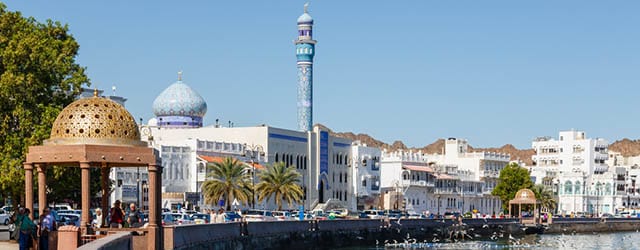The sultanate’s proximity to the Gulf has long been an attraction. But with war in neighboring Yemen, its location could be a drawback.

When it comes to foreign direct investment (FDI), Oman remains a mixed bag of risk and reward. Officials are actively courting capital from abroad, particularly for the oil and gas sectors, as well as manufacturing and financial services. Government incentives include tax breaks and customs duty exemptions. But fallout from the Omani Spring—along with the civil war in Yemen—threatens political stability in the oldest state in the Arab world. And the recent health problems of the nation’s leader, sultan Qaboos bin Said al Said, may stall fiscal and economic reforms.
To boost FDI—and partially to appease political protesters—the government undertook an anticorruption campaign in 2013 that led to the sentencing of a number of high-ranking officials. It’s still unclear whether the much-publicized prosecutions quelled dissenters or eased the worries of potential global investors.
The Foreign Capital Investment Law requires a 30% Omani stake for most enterprises, but permits exceptions, such as ownership of foreign bank branches. And under the US-Omani FTA, companies can hold 100% ownership in a business in Oman without a local partner.
Despite a relatively liberal investment climate, doing business in Oman requires patience—and a healthy risk tolerance. The Heritage Foundation gives it a “moderately free” designation as it needs reforms to improve transparency and efficiency. Example: Enforcing a business contract takes up to 600 days and fifty procedures.
Other concerns abound. The medical condition of sultan Qaboos may top the list. “It injects uncertainty … which obviously business doesn’t like from an investment and planning perspective,” says Henry Smith, Control Risks’ senior consultant, Middle East and North Africa.
Indeed, sultan Qaboos’s recent medical problems forced the monarch to the sidelines for eight months. During his absence, officials in Muscat reportedly hesitated to make important decisions on policy and programs. Complicating matters: Qaboos does not have a clear heir apparent.
The fighting in Yemen, Oman’s neighbor, also muddies the situation. Continued bloodshed could lead to a flood of Yemeni refugees into Oman. The exodus could threaten the stability of Dhofar in southern Oman, according to a paper written by Marc Valeri of the Carnegie Middle East Center.
Still, Oman has its selling points. The country is the gateway to the Arab Gulf. Its capital, Muscat, is making investments in the country’s transportation networks. As of 2013, GDP per capita was close to $22,000. And Oman ranks 66th out of 189 countries in Transparency International’s latest Ease of Doing Business survey.
Smith at Control Risks advises foreign corporations to conduct stress-testing when considering investing in Oman. Such an analysis involves selecting different scenarios and assessing the potential impact of each one on a project. “If you’re coming out of that exercise with a pretty good percentage probability that you’ll be alright,” he says, “then maybe it’s within your appetite to shoulder that risk.”
Vital Statistics |
|---|
|
Location: Arabian Peninsula |
|
Neighbors: United Arab Emirates, Saudi Arabia, Yemen |
|
Capital city: Muscat |
|
Population: 3,632,444 (2013) |
|
Official language: Arabic (English is frequently spoken) |
|
GDP per capita (2013): $21,929 |
|
GDP growth (2012): 5.8% |
|
Inflation (2013): 1.2% |
|
Currency: Rial |
|
Investment promotion agency: The Public Authority for Investment Promotion and Export Development: https://ithraa.om/EN/Pages/Home.aspx |
|
Investment incentives available? Tax and duty relief in Free Zones |
|
Ease of Doing Business rank: 66 out of 189 (2014) |
|
Corruption Perceptions Index rank: 64 out of 174 (2014) |
|
Political risk: Possibility of renewed protests following the Omani Spring of 2011 and 2012; some political uncertainty, owing to government reluctance to appoint a prime minster, raising questions about succession plan; young activists reported unlikely to accept a successor who merely continues sultan Qaboos’s approach |
|
Security risk: Proximity to Yemen, which is engulfed in a civil war, and the porous border between the two countries |
PROS |
Cons |
|---|---|
| Major commitments for improving transportation and logistics | Unknown net impact of dropping oil prices |
| Recently opened shipping terminal; also substantially increased the number of flight destinations for Oman Air | Oman needs a fiscal break-even price of $102.60 per barrel* |
| Partnered with Brunei sovereign wealth funds to invest in and manage purchase and lease of commercial aircraft operations | Spending cuts possible, depending on price developments |
| Reports of problems over duty exemptions | |
| Hiring quotas and gas shortages | |
| Inconsistency in interpretation of the FTA Trade Agreement between differing Omani government agencies, such as the Ministry of Commerce and the Ministry of Manpower. |
Sources: Associated Press Report March 23 2015. Fitch Ratings. Heritage Foundation. International Monetary Fund**. National Center for Statistics and Information. Oman Daily Observer. RBC Capital*. Simmering Unrest and Succession Challenges in Oman, a paper by Marc Valeri, Carnegie Middle East Center. State Department. Times of Oman. Transparency International. World Bank.
For more information on Oman, check out our Country Economic Reports.



